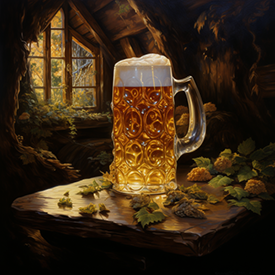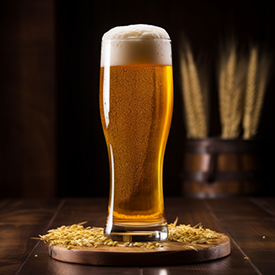There Really Are Only Two Types of Beer
Posted by Matteo Lahm on 15th Jan 2025
You're here because you love beer. And not just any beer, but the good stuff. The kind that makes you sit back, take a sip, and think, "Wow, this is something special." But have you ever wondered what makes your favorite brew tick?
Every beer you've ever enjoyed, whether it was a frosty lager on a hot summer day or a hearty ale by the fireside, falls into one of these two categories. But what's the difference? It all boils down to the yeast and the brewing process.

Let's start with the yeast. Ales are brewed with top-fermenting yeast, known as Saccharomyces cerevisiae. This little guy likes to work at warmer temperatures, usually between 60-75°F. It ferments quickly, and as it does, it creates a rich, complex array of flavors and aromas. Think fruity, spicy, and sometimes downright funky.
On the other hand, lagers are made with bottom-fermenting yeast, or Saccharomyces pastorianus, if you want to get technical. This yeast prefers cooler temperatures, around 45-55°F, and it works at a slower pace. The result? A beer that's clean, crisp, and smooth, with a more subtle flavor profile.
Now, let's talk about the brewing process. Ale brewing is a bit like a sprint. It's fast and furious, with fermentation taking just a few days. But don't let that fool you. Ales can pack a punch when it comes to flavor and complexity.
Lager brewing, on the other hand, is more of a marathon. After primary fermentation, lagers go through a lengthy lagering period at cold temperatures. This can last anywhere from a few weeks to several months. The result is a beer that's smooth, refined, and well worth the wait.
Now, you might be wondering, "What about porters, stouts, and pilsners? Where do they fit into this ale and lager narrative?" Well, let's unravel that mystery.
Porters and stouts are subcategories of ales. They're like the brooding, mysterious cousins in the ale family. Porters originated in London, designed to be robust and hearty for the city's hard-working porters. They're known for their dark, almost black color, and flavors that can range from chocolate to caramel to coffee. Stouts are essentially a stronger version of porters - hence the name, which means "strong." They're rich, dark, and full-bodied, with flavors that can remind you of everything from coffee and chocolate to dried fruit and licorice.

Pilsners, on the other hand, are a type of lager. Born in the Czech city of Pilsen, these beers are golden and crystal clear, with a delicate, refreshing flavor that's often described as crisp and slightly bitter. They're the perfect antidote to a hot summer day, or really, any day when you're in the mood for something light and refreshing.
As for flavors and alcohol content, ales generally have a wide range. They can be light and fruity, dark and malty, or anywhere in between. Their alcohol content can vary greatly too, from session ales with as low as 3% ABV (Alcohol By Volume) to hefty Belgian ales that can reach up to 12% ABV or more.
Lagers, on the other hand, are typically lighter in flavor, though there are exceptions like the Doppelbock, which can be quite malty and strong. They're often described as clean and crisp, thanks to the lagering process that gives them a smooth, refined character. The alcohol content in lagers is usually on the lower side, with most ranging from 4-6% ABV. But again, there are exceptions. Some Bocks and Doppelbocks can reach up to 7-13% ABV.
So, whether you're a fan of the bold, complex flavors of ales or the smooth, subtle charm of lagers, there's a beer out there for you. And within each category, there's a world of styles to explore, each with its own unique flavor profile and story.
So, next time you're sipping on your favorite brew, take a moment to appreciate the magic that went into making it. Whether it's an ale or a lager, there's a whole world of science, art, and tradition in every glass. And remember, the best kind of beer is the one you enjoy the most. So, keep exploring, keep tasting, and keep enjoying the wonderful world of beer. Cheers to you and your next beer adventure!

